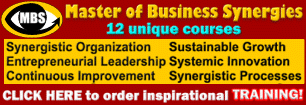|
Effective Communication The Art, Science, and Practice |
|
 |
 |
Knowing Yourself and Others
Asking Effective Questions
|
Attitude Is Infectious and Drives Behavior Your attitude is the first thing people pick up on in face-to-face communication.6 Just as laughing, yawning, and crying are infectious, attitude is infectious. Before you say a word, your attitudes can infect the people who see you with the same behavior. Somehow just by looking or feeling, you can be infected by another person's attitude, and vice versa. When you are operating from inside a really useful attitude, such as enthusiasm, curiosity, and humility, your body language tends to take care of itself and sends out unmistakable signals of openness... MoreEffective Speaking Perhaps the greatest single stumbling block to real communication is the one-sided nature of speaking. Most of us think of "communicating" as a one-way process. Two monologues do not make a dialogue, however. Exchange between you and your targeted prospect is the key to effective communication. So, listening is an active pursuit for selling your ideas. What makes people listen? The three basic factors are:
Understanding the basic principles of how we communicate and why we listen - what works, what doesn't, and why - starts you on the road to a realistic appraisal of what you want to say and how you plan to say it... MoreEffective Listening Often we have too much difficulty listening to other people because3:
Non-verbal Communication Communication is not just about the words you use. In fact, you communicate more with your gestures and expressions, your body language. "Start to notice your body language, and other people's and see how much you can pick up about what someone saying just by watching them."1...More NLP Solutions: How To Prevent Misunderstanding Rapport is the first step in good communication. We are all excellent communicators - and still we are misunderstood, for we are not only gifted and creative communicators, we are also gifted and creative receivers. A sender cannot decide what the signal will actually mean to the other person, only what they would like it to mean. When you mean one thing and the other person shows you by their response that they have a different meaning, nobody is wrong and nobody is to blame. How misunderstandings can be prevented? This is usually done by paying attention to the other person's response. The responses you get give you valuable pointers about what to do next. One NLP presupposition sums this up: "The meaning of the communication is the response you get". Cross-Cultural Communication Challenges Culture is often at the root of communication challenges. Exploring historical experiences and the ways in which various cultural groups have related to each other is key to opening channels for cross-cultural communication. Becoming more aware of cultural differences, as well as exploring cultural similarities, can help you communicate with others more effectively. Next time you find yourself in a confusing situation, ask yourself how culture may be shaping your own reactions, and try to see the world from the other's point of view...More Taking the Preferred Styles Into Account To work effectively with people, take their preferred style of interaction and decision-making into account. Many misunderstandings derive from differences in style. For example, "Perceivers" may see "Judgers" as unwilling to take the time to explore creative options. Conversely, "Judgers" can become irritated by "Perceivers" who may stray from the agenda...More Understanding Mental Maps A Mental Map is a powerful way of expressing the though patterns, pictures and associations that already exist in the brain. Different people take in the world through different senses. People have different preferred ways of thinking and communicating their experiences - some express themselves in pictures, others talk about how things sound to them, and others speak about how things feel. If you want to connect with them, you have to figure out which sense they favor...More Creating Rapport "To create rapport, it is important to mirror, match, and pace the person or persons with whom you are communicating."3 Rapport is a process of building a sustaining relationship of mutual trust, harmony and understanding. It is essentially meeting individuals in their model of the world...More
|
Bibliography:
-
"Super Communication the NLP Way", Russel Webster, 2000
-
"Understanding Body Language", Geoff Ribbens and Richard Thompson, 2000
-
"101 Ways To Generate Great Ideas", Timothy R.V. Foster, 2001
-
"Simplicity - The New Competitive Advantage in a World of More, Better, Faster", Bill Jensen, 2000
-
"Secrets of Power Persuasion for Salespeople", Roger Dawson, 2003
-
"How To Connect in Business in 90 Seconds or Less", Nicholas Boothman, 2002



